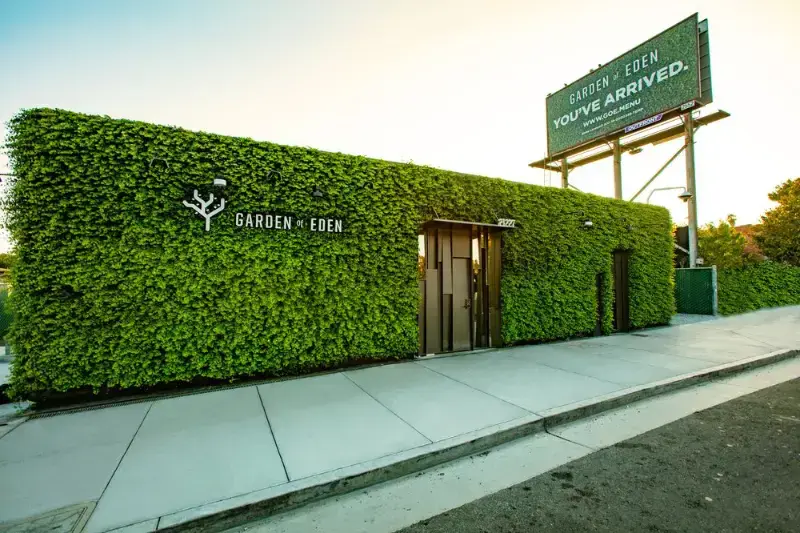The Eden Icon Legend aims to be a shorthand language that helps consumers select the cannabis products that matches tastes and objectives. Flavor Groups, Terpene Types, and Cannabinoids are the dimensions that tell the connoisseur all they need to know.
Flavor Groups
The flavor of a particular cannabis plant comes from its terpene composition. Plants produce terpenes in order to attract pollinators – like pheromones in humans. A given cannabis plant always contains multiple terpenes and each can have a distinct aroma. You smell and taste an amalgamation. Describing the taste of cannabis is every bit as the experience of tasting Scotch. The unfolding of the sensory experience is often about “notes” and “hints.” The flavor sensations during the breath cycle often change. Sometimes flavors are subtle and other times they can be overwhelming. You can think of the flavors listed below as neighborhoods of taste and smell. And remember, your nose knows.

A “purple” cannabis strain profile refers to strains that display rich purple coloration in their buds, leaves, or stems—an effect often caused by elevated levels of anthocyanins, which are naturally occurring pigments that become more prominent in cooler growing temperatures or specific genetic lineages. These strains are commonly associated with sweet, berry-like, or grape-forward aromas and flavors, sometimes with earthy or floral undertones. In terms of effects, purple strains are typically Indica-dominant or hybrids, known for their deeply relaxing, sedative qualities, making them popular choices for evening use, stress relief, and pain management.
The Fruit smell in cannabis is about detecting “hint notes” of blueberries, strawberries, bananas. The smells can be subtle and sometimes appear in the back half of the inhale. Advanced connoisseurs learn to give their noses permission to call out what shows up in the screens of the mind.

A “citrus” cannabis strain profile is characterized by bright, zesty aromas and flavors reminiscent of lemons, oranges, tangerines, or limes. These notes are typically the result of high concentrations of terpenes like limonene, terpinolene, and valencene, which not only contribute to the citrus scent but are also believed to promote uplifting, energizing, and mood-boosting effects. Citrus-flavored strains are often Sativa-dominant or balanced hybrids, making them popular for daytime use, creativity, and combating fatigue or stress.
Think of gently filling your nostrils with a freshly opened bag of sweet tarts. Conjure candy sugar versus fruit sugar. Imagine a first bite of vanilla ice cream. Sweet is the EASY button for pleasuring your tongue.
Have you ever walked through a pine forest in the morning dew? That crisp, cool, fresh green smell usually spells the word CLEAN in our minds. This is why Pine Sol is a very successful cleaning product. This nose landscape also includes the smell of freshly cut grass. Its the smell of green.
The juice of a meyer lemon or the tang of pickled red onions are examples of the sour acid landscape.
Terpene Type
As we saw in the Flavors section, terpenes are not exclusive to the cannabis plant. They interact with our sense of taste and smell and are naturally occurring in most plants as a form of defense, but also to welcome pollinators. There are several processes to extract terpenes with the ultimate goal of preserving the nose of the strain profile.
Terpenes extracted from a cannabis plant while the plant is still ALIVE using steam distillation. This method was pioneered in Alameda County and is reputed to be the freshest expression of the taste of field cannabis.
A preserved collection of cannabis oils, terpenes, flavors, and aromas extracted from a cannabis plant. It’s like a fingerprint of your favorite strains!
Live Rosin is an extraction method that includes the full spectrum of cannabinoids, flavonoids, and terpenes of the flower bud. Live Rosin the product of a pressed cannabis flower bud.
Botanical terpenes are terpenes supplemented by essential oils of non cannabis plant species. Plants of all kinds produce aromas as a defense mechanism from predator’s, also to welcome pollinators.
Cannabinoids
There is still much to know about cannabinoids. What we do know is that cannabinoids is that they are naturally occurring compounds that are present the cannabis plant. Cannabinoids will exert their specific effects by interacting with specific cannabinoid receptors on the surface of the cell. Learn about the cannabinoids commonly seen in cannabis products.
Tetrahydrocannabinol (THC), the main psychoactive compound in the cannabis plant. This is the ORIGINAL cannabinoid that the world became familiar with as the compound that gets a person “high.”
Cannabidiol (CBD) is the other major cannabinoid along with THC and it is known as the compound that does not produce the sensation of being “High.” This compound is known is associated with body relaxation and an ever increasing list of other health benefits.
Cannabinol (CBN) is a cannabinoid that is typically present in degraded flower and often induces feeling of relaxation. CBN is often included in products that are labeled as “RELAX” or “NIGHTIME”.
Start your morning off with this cerebral cannabinoid. THCv is a form of THC that is often added to products that contain words like FOCUS and ENERGIZED.
Delta 8 THC is a cannabinoid that is often referred to as THC-lite since it doesn’t typically invoke as much psycho-activity as Delta 9 THC.
CBG, similar to CBD, is a non-intoxicating cannabinoid that can counteract the effects of other cannabinoids, such as THC. CBG can be used in an effort to relieve pain.
THCa is the precursor for THC. Like other cannabinoids, they start off in the acidic form. When they are exposed to light it will enter a process called decarboxylation that will then turn THCa into THC.




